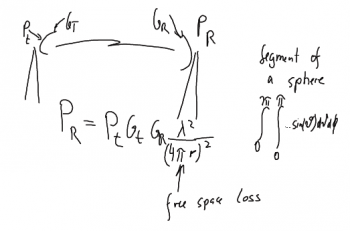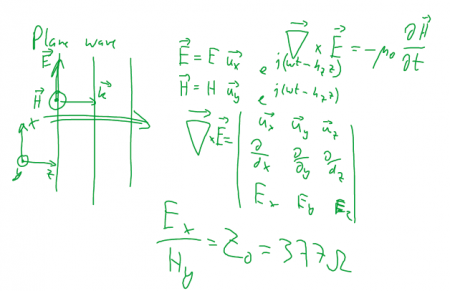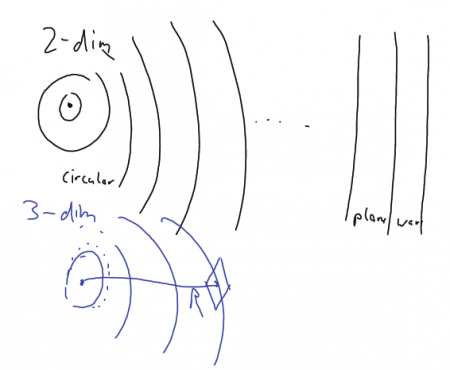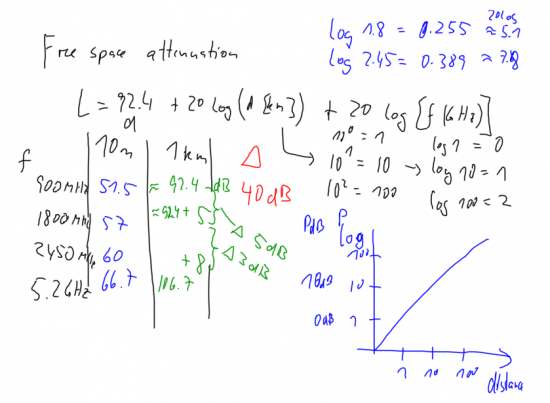Difference between revisions of "B1-Free Space Propagation"
Josef.Noll (Talk | contribs) |
Josef.Noll (Talk | contribs) |
||
| Line 1: | Line 1: | ||
| − | + | ||
| + | =⌘ Maxwell's Equation in a source free environment = | ||
| + | Source free environment and free space: | ||
| + | |||
| + | <math> \nabla \cdot \vec E = 0 \qquad \qquad \qquad \ \ (1) </math> | ||
| + | |||
| + | <math>\nabla \times \vec E = -\frac{\partial}{\partial t} \vec B \qquad \qquad (2) </math> | ||
| + | |||
| + | <math> \nabla \cdot \vec B = 0 \qquad \qquad \qquad \ \ (3) </math> | ||
| + | |||
| + | <math> \nabla \times \vec B = \mu_0 \epsilon_0 \frac{\partial}{\partial t} \vec E \qquad \ \ \ (4) </math> | ||
| + | |||
| + | where div is a scalar function<br /> | ||
| + | <math>\mbox{div}\,\vec v = {\partial v_x \over \partial x} + {\partial v_y \over \partial y} + {\partial v_z \over \partial z} = \nabla \cdot \vec v </math><br /> | ||
| + | and curl is a vector function <br /> | ||
| + | <math>\mbox{curl}\;\vec v = \left( {\partial v_z \over \partial y} - {\partial v_y \over \partial z} \right) \mathbf{i} + \left( {\partial v_x \over \partial z} - {\partial v_z \over \partial x} \right) \mathbf{j} + \left( {\partial v_y \over \partial x} - {\partial v_x \over \partial y} \right) \mathbf{k} = \nabla \times \vec v</math> | ||
| + | |||
| + | [Source: Wikipedia] | ||
| + | |||
| + | |||
| + | |||
| + | =⌘ Wave equation = | ||
| + | Taking the curl of Maxwell's equation | ||
| + | |||
| + | <math>\nabla \times \nabla \times \vec E = -\frac{\partial } {\partial t} \nabla \times \vec B = -\mu_0 \varepsilon_0 \frac{\partial^2 \vec E } {\partial t^2} </math> | ||
| + | |||
| + | <math>\nabla \times \nabla \times \vec B = \mu_0 \varepsilon_0 \frac{\partial } {\partial t} \nabla \times \vec E = -\mu_o \varepsilon_o \frac{\partial^2 \vec B}{\partial t^2} </math> | ||
| + | |||
| + | yields the wave equation:<br /> | ||
| + | <math>{\partial^2 \vec E \over \partial t^2} \ - \ {c_0}^2 \cdot \nabla^2 \vec E \ \ = \ \ 0 </math> | ||
| + | |||
| + | <math>{\partial^2 \vec B \over \partial t^2} \ - \ {c_0}^2 \cdot \nabla^2 \vec B \ \ = \ \ 0 </math> | ||
| + | |||
| + | with <math> c_0 = { 1 \over \sqrt{ \mu_0 \varepsilon_0 } } = 2.99792458 \times 10^8 </math> m/s | ||
| + | |||
| + | [Source: Wikipedia] | ||
| + | |||
| + | =⌘ Homogeneous electromagnetic wave = | ||
| + | single frequency | ||
| + | |||
| + | <math>\vec E(\vec r) = E_0 e^{j(\omega t - \vec k \cdot \vec r) } </math>, | ||
| + | |||
| + | <math>\vec B(\vec r) = B_0 e^{j(\omega t - \vec k \cdot \vec r) } </math>, | ||
| + | |||
| + | [Source: Wikipedia] | ||
| + | |||
| + | where | ||
| + | * <math>\vec r = (x, y, z) </math> and <math>\vec k = (k_x, k_y, k_z) </math> <span style="color:#000B80">so? | ||
| + | * <math>j \, </math> is the imaginary unit | ||
| + | * <math>\omega = 2 \pi f \, </math> is the angular frequency, [rad/s] | ||
| + | * <math> f \,</math> is the frequency [1/s] | ||
| + | * <math> e^{j \omega t} = \cos(\omega t) + j \sin(\omega t) </math> is Euler's formula | ||
| + | |||
| + | with <math>c = { c_0 \over n } = { 1 \over \sqrt{ \mu \varepsilon } } </math> and | ||
| + | <math>n = \sqrt{ \mu \varepsilon \over \mu_0 \varepsilon_0 </math> | ||
| + | |||
| + | |||
| + | |||
| + | |||
| + | ==⌘ Comments and tasks == | ||
| + | |||
| + | * What is the difference between a static and a dynamic field | ||
| + | * Develop the relations for a plain wave | ||
| + | |||
| + | |||
| + | * Assume a plane wave: <math>E_x, H_y</math>. Show that <math>\frac{E_x}{H_y}=Z_0 = \sqrt{\mu_0/\varepsilon_0}</math> | ||
| + | |||
[[File:f3-8.png|450px|right|Calculation of a plane wave, proove that Z_0 = ... = E_x/H_y]] | [[File:f3-8.png|450px|right|Calculation of a plane wave, proove that Z_0 = ... = E_x/H_y]] | ||
Revision as of 10:29, 21 September 2014
| Wiki for ITS | ||||||
|---|---|---|---|---|---|---|
|
Contents
⌘ Maxwell's Equation in a source free environment
Source free environment and free space:
where div is a scalar function
and curl is a vector function
[Source: Wikipedia]
⌘ Wave equation
Taking the curl of Maxwell's equation
yields the wave equation:
with m/s
[Source: Wikipedia]
⌘ Homogeneous electromagnetic wave
single frequency
,
,
[Source: Wikipedia]
where
-
and
so?
-
is the imaginary unit
-
is the angular frequency, [rad/s]
-
is the frequency [1/s]
-
is Euler's formula
with and
⌘ Comments and tasks
- What is the difference between a static and a dynamic field
- Develop the relations for a plain wave
- Assume a plane wave:
. Show that
⌘ Task: Plane wave propagation
Assume a plane wave: . Show that
What is the relation between a plane wave and an omnidirectional wave?
⌘ Free space propagation
develop propagation equation, see (http://www.antenna-theory.com/basics/friis.php)
Power received in an area in a distance R from transmitter:
- area of a sphere is
- power transmitted from isotropic antenna is
- antenna area of receiver is
- power received in A_r = P_r
thus
- convert into dB
- provide examples for f = 10 MHz, 1 GHz, 100 GHz
- discuss influences on radiation pattern
How much is 0 dB_m and 10 dB_m?
- Convert dBm to mW is: mW = 10^(x/10), x = number of dBm
- Convert mW to dBm is: dBm = 10*log10(y), y = number of mW
So you get:
- 0 dBm = 10^(0/10) = 1 mW
- 10 dBm = 10^(10/10) = 10 mW
Free space attenuation
⌘Comments

|
Free space propagation from a transmit (t) to a receive (r) station. |
Calculation of free space attenuation. Note the increased free-space attenuation of approx 5 dB from 900 to 1800 Unik/MHz, and a further increase of 3 dB from 1800 (GSM 1800) to 2450 Unik/MHz (802.11b). Note also that increasing the distance by a factor of 10 will increase the power requirements by 20 dB.
Free space propagation Calculation: http://spreadsheets.google.com/pub?key=p0EyjWrbirGKJXK43uluJfg


